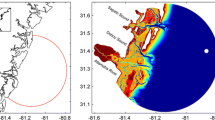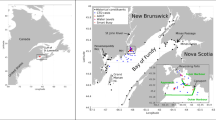Abstract
Water circulation in Puget Sound, a large complex estuary system in the Pacific Northwest coastal ocean of the United States, is governed by multiple spatially and temporally varying forcings from tides, atmosphere (wind, heating/cooling, precipitation/evaporation, pressure), and river inflows. In addition, the hydrodynamic response is affected strongly by geomorphic features, such as fjord-like bathymetry and complex shoreline features, resulting in many distinguishing characteristics in its main and sub-basins. To better understand the details of circulation features in Puget Sound and to assist with proposed nearshore restoration actions for improving water quality and the ecological health of Puget Sound, a high-resolution (around 50 m in estuaries and tide flats) hydrodynamic model for the entire Puget Sound was needed. Here, a three-dimensional circulation model of Puget Sound using an unstructured-grid finite volume coastal ocean model is presented. The model was constructed with sufficient resolution in the nearshore region to address the complex coastline, multi-tidal channels, and tide flats. Model open boundaries were extended to the entrance of the Strait of Juan de Fuca and the northern end of the Strait of Georgia to account for the influences of ocean water intrusion from the Strait of Juan de Fuca and the Fraser River plume from the Strait of Georgia, respectively. Comparisons of model results, observed data, and associated error statistics for tidal elevation, velocity, temperature, and salinity indicate that the model is capable of simulating the general circulation patterns on the scale of a large estuarine system as well as detailed hydrodynamics in the nearshore tide flats. Tidal characteristics, temperature/salinity stratification, mean circulation, and river plumes in estuaries with tide flats are discussed.















Similar content being viewed by others
References
Aoki K, Isobe A (2007) Application of finite volume coastal ocean model to hindcasting the wind-induced sea-level variation in Fukuoka bay. J Oceanogr 63(2):333–339
Babson AL, Kawase M, MacCready P (2006) Seasonal and interannual variability in the circulation of Puget Sound, Washington: a box model. Atmos Ocean 44(1):29–45
Barnes CA, Collias EE (1958) Some considerations of oxygen utilization rates in Puget Sound. J Mar Res 17:68–80
Barnes CA, Ebbesmeyer CC (1978) Some aspects of Puget Sound’s circulation and water properties. In: Bjorn Kjerfve (ed) In Estuarine Transport Processes. University of South Carolina Press, Columbia South Carolina, pp 209–228
Blumberg AF, Mellor GL (1987) A description of a 3-D coastal ocean circulation model. In: Heaps N (ed) Three-Dimensional Coastal Ocean Models. American Geophysical Union, Washington, DC, pp 1–16
Bretschneider DE, Cannon GA, Holbrook JR, Pashinski DJ (1985) Variability of subtidal current structure in a fjord estuary: Puget Sound, Washington. J Geophys Res 90(C6):11949–11958. doi:10.1029/JC090iC06p11949
Cannon GA (1983). An overview of circulation in the Puget Sound estuarine system. NOAA Technical Memorandum ERL PMEL-48. NOAA, Washington, DC, 30 pp
Cannon AC, Ebbesmeyer CC (1978) Winter replacement of bottom water in Puget Sound. In: Kjerfve B (ed) Estuarine Transport Processes. University of South Carolina Press, Columbia, pp 229–238
Chen C, Rawson M (2005) An ecosystem management model system for the Satilla River Estuary, Georgia. Oceans, 2005. Proc MTS IEEE 1:622–632
Chen C, Liu H, Beardsley RC (2003) An unstructured, finite-volume, three-dimensional, primitive equation ocean model: application to coastal ocean and estuaries. J Atm Oceanic Tech 20:159–186
Chen C, Beardsley RC, Cowles G (2006) An unstructured grid, finite-volume coastal ocean model (FVCOM) system. Special Issue entitled “Advance in Computational Oceanography”. Oceanography 19(1):78–89
Chen C, Gao G, Qi J, Proshutinsky A, Beardsley RC, Kowalik Z, Lin H, Cowles G (2009) A new high-resolution unstructured-grid finite-volume Arctic Ocean model (AO-FVCOM): an application for tidal studies. J Geophys Res. doi:10.1029/2008jc004941
Cokelet ED, Stewart RJ, Ebbesmeyer CC (1990). The annual mean transport in Puget Sound. NOAA Technical Memorandum ERL PMEL-92. NOAA, Washington, DC
Collias E (1972). The salt water system of Washington State. Washington State Department Ecology Report. Washington State Department Ecology, Olympia, 24 pp
County K (2001) Features of Puget Sound region: oceanography and physical processes. Chapter 3 in the State of the Nearshore Report. Department of Natural Resources, Seattle
Crawford WR, Cherniawsky JY, Cummins PF (1999) Surface currents in British Columbia waters: comparison of observations and model predictions. Atmos Ocean 37:255–280
Crean PB (1978) A numerical model of barotropic mixed tides between Vancouver Island and the mainland and its relation to studies of the estuarine circulation. In: Nihoul JC (ed) Hydrodynamics of estuaries and fjords. Elsevier, Amsterdam, pp 283–313
Cummins PF, Oey LY (1997) Simulation of barotropic and baroclinic tides off northern British Columbia. J Phys Oceanogr 27:762–781
Cummins PF, Masson D, Foreman MGG (2000) Stratification and mean flow effects on diurnal tidal currents off Vancouver Island. J Phys Oceanogr 30:15–30
de Brye B, de Brauwere A, Gourgue O, Kärnä T, Lambrechts J, Comblen R, Deleersnijder E (2010) A finite-element, multi-scale model of the Scheldt tributaries, river, estuary and ROFI. J Coast Eng 57:850–863
Ebbesmeyer CC, Barnes CA (1980) Control of a fjord basin’s dynamics by tidal mixing in embracing sill zones. Estuarine and Coastal Mar Sci 11:311–330
Ebbesmeyer CC, Coomes CA (1989) Strong low frequency decadal environmental fluctuations during the 20th Century in the North Pacific Ocean, on the Washington Coast, and in Puget Sound. Oceans 89 Proceedings 1:242–246
Ebbesmeyer CC, Cannon GA, Nairn BJ, Kawase M, Fox B (2002) Puget Sound physical oceanography related to the Triple Junction region. Prepared for King County Department of Natural Resources and Parks. King County Department of Natural Resources and Parks, Seattle
Foreman M, Henry R, Walters R, Ballantyne V (1993) A finite element model for tides and resonance along the north coast of British Columbia. J Geophys Res 98(C2):2509–2531
Hickey BM, Banas NS (2003) Oceanography of the U.S. Pacific Northwest coastal ocean and estuaries with application to coastal ecology. Estuaries 26(4B):1010–1031
Huang HC, Chen JO, Blanton FA, Andreade (2008) Numerical study of tidal asymmetry in the Okatee Creek, South Carolina, Estuaries. Coastal and Shelf Science 78:190–202
Isobe A, Beardsley RC (2006) An estimate of the cross-frontal transport at the shelf break of the East China Sea with the Finite Volume Coastal Ocean Model. J Geophys Res 111:C03012. doi:10.1029/2005JC003290
Ji R, Davis C, Chen C, Beardsley R (2008) Influence of local and external processes on the annual nitrogen cycle and primary productivity on Georges Bank: a 3-D biological-physical modeling study. J Mar Syst 73:31–47
Ji R, Davis C, Chen C, Beardsley RC (2009) Life history traits and spatiotemporal distributional patterns of copepod populations in the Gulf of Maine-Georges Bank region. Mar Ecol Prog Ser 384:187–205. doi:10.3354/meps08032
Large WG, Pond S (1981) Open ocean momentum flux measurements in moderate to strong winds. J Phys Oceanogr 11:324–336
Lavelle JW, Mofjeld HD, Lempriere-Doggett E, Cannon GA, Pashinski DJ (1988). A multiply-connected channel model of tides and tidal currents in Puget Sound, Washington and a comparison with updated observations. NOAA Technical Memorandum ERL PMEL-84. NOAA, Washington, DC, 103 pp
Lavelle JW, Cokelet ED, Cannon GA (1991) A model study of density intrusions into and circulation within a deep, silled estuary—Puget Sound. J Geophys Res Oceans 96(C9):16779–16800
Li C, Chen C, Guadagnoli G, Georgiou IY (2008) Geometry induced residual eddies in estuaries with curved channel-observations and modeling studies. J Geophys Res 113:C01005. doi:10.1029/2006JC004031
Logutov OG, Lermusiaux PFJ (2008) Inverse barotropic tidal estimation for regional ocean applications. Ocean Model 25:17–34. doi:10.1016/j.ocemod.2008.06.004
Masson D, Cummins PF (2004) Observations and modeling of seasonal variability in the Straits of Georgia and Juan de Fuca. J Mar Res 62:491–516
Masson D, Cummins PF (2000) Fortnightly modulation of the estuarine circulation in Juan de Fuca Strait. J Mar Res 58:439–463
Mellor GL, Blumberg A (2004) Wave breaking and ocean surface layer thermal response. J Phys Oceanogr 34:693–698
Mellor GL, Yamada T (1982) Development of a turbulence closure model for geophysical fluid problems. Rev Geophys Space Phys 20:851–875
Mofjeld HO, Larsen LR (1984). Tides and tidal currents in the inland waters of Western Washington. NOAA Technical Memorandum ERL PMEL-56. NOAA, Washington, DC, 52 pp
Moore SK, Mantua NJ, Newton JA, Kawase M, Warner MJ, Kellogg JP (2008a) A descriptive analysis of temporal and spatial patterns of variability in Puget Sound oceanographic properties. Estuar Coast Shelf Sci 80:545–554
Moore SK, Mantua NJ, Kellogg JP, Newton JA (2008b) Local and large-scale climate forcing of Puget Sound oceanographic properties on seasonal to interdecadal timescales. Limnol Oceanogr 53:1746–1758
Nairn BJ, Kawase M (2002). Comparison of observed circulation patterns and numerical model predictions in Puget Sound, WA. In: Droscher T (ed) Proceedings of the 2001 Puget Sound Research Conference, Puget Sound Water Quality Action Team, Olympia, Washington
Pond S, Pickard GL (1983) Introduction to Dynamical Oceanography, 2nd edn. Butterworth-Heinemann Ltd, Woburn
Public Utility District No. 1 of Snohomish County (2007). Tidal current Survey, Admiralty Inlet of Puget Sound, WA. Snohomish County PUD, Everett
Qi JC, Chen RC, Beardsley WP, Cowles G (2009) An unstructured-grid finite-volume surface wave model (FVCOM-SWAVE): implementation, validations and applications. Ocean Model 28:153–166. doi:10.1016/j.ocemod.2009.01.007
Smagorinsky J (1963) General circulation experiments with the primitive equations. I. The basic experiment. Mon Weather Rev 91:99–164
Sternberg RW (1968) Friction factors in tidal channels with differing bed roughness. Mar Geol 6:243–260
Tian R, Chen C, Stokesbury KDE, Rothschild BJ, Xu Q, Hu S, Cowles G, Harris BP, Marino MC II (2009) Modeling exploration of the connectivity between sea scallop populations in the Middle Atlantic Bight and over Georges Bank. Mar Ecol Prog Ser 380:147–160. doi:10.3354/meps07916
U. S. Geological Survey (1979). Feature detail report for Puget Sound. Report ID 1507653. U. S. Geological Survey, Reston
U. S. Geological Survey (2007). Nitrogen to Hood Canal and Lynch Cove, Washington. Scientific Investigations Report 2006-5106. Version 1.10, August 2007. U. S. Geological Survey, Reston, 104 pp
Wang B, Fringer OB, Giddings SN, Fong DA (2009) High-resolution simulations of a macrotidal estuary using SUNTANS. Ocean Model 26:60–85
Washington Department of Ecology (2008). South Puget Sound Dissolved Oxygen Study, Interim Data Report. Publication No. 08-03-037, December 2008. Washington Department of Ecology, Olympia, 167 pp
Weisberg RH, Zheng L (2006a) Circulation of Tampa Bay driven by buoyancy, tides, and winds, as simulated using a finite volume coastal ocean model. J Geophys Res 111:C01005. doi:10.1029/2005JC003067
Weisberg RH, Zheng L (2006b) Hurricane storm surge simulations for Tampa Bay. Estuaries Coasts 29(6A):899–913
Xue P, Chen C, Ding P, Beardsley RC, Lin H, Ge J, Kong Y (2009) Saltwater intrusion into the Changjiang River: a model-guided mechanism study. J Geophys Res 114:C02006. doi:10.1029/2008JC004831
Yang Z, Khangaonkar T (2009) Modeling tidal circulation and stratification in Skagit River estuary using an unstructured grid ocean model. Ocean Model 28:34–49. doi:10.1016/j.ocemod.2008.07.004
Yang Z, Khangaonkar T, Calvi M, Nelson K (2010a) Simulation of cumulative effects of nearshore restoration projects on estuarine hydrodynamics. Ecol Model 221:969–977. doi:10.1016/j.ecolmodel.2008.12.006
Yang Z, Sobocinski KL, Heatwole D, Khangaonkar T, Thom R, Fuller R (2010b) Hydrodynamic and ecological assessment of nearshore restoration: a modeling study. Ecol Model 221:1043–1053. doi:10.1016/j.ecolmodel.2009.07.011
Yang Z, Khangaonkar T, Wang T (2011). Use of advanced meteorological model output for coastal ocean modeling in Puget Sound. Int J of Climate and Ocean Sys (in press)
Zhao L, Chen C, Cowles G (2006) Tidal flushing and eddy formation in Mount Hope Bay and Narragansett Bay: an application of FVCOM. J Geophys Res 111:C10015. doi:10.1029/2005JC003135
Zheng L, Chen C, Liu H (2003) A modeling study of the Satilla River Estuary, Georgia. Part I: flooding/drying process and water exchange over the salt marsh-estuary-shelf complex. Estuaries 26(3):651–669
Acknowledgements
This study is primarily funded by the Laboratory Directed Research and Development grants of the Pacific Northwest National Laboratory and subsequently partially supported by various funding sources, including a grant from the U.S. Department of Energy as part of the Energy Efficiency and Renewable Energy program. The authors thank Dr. Taiping Wang for assisting with harmonic analysis and error assessment of the model results and figures.
Author information
Authors and Affiliations
Corresponding author
Additional information
Responsible Editor: Pierre Lermusiaux
Rights and permissions
About this article
Cite this article
Yang, Z., Khangaonkar, T. Multi-scale modeling of Puget Sound using an unstructured-grid coastal ocean model: from tide flats to estuaries and coastal waters. Ocean Dynamics 60, 1621–1637 (2010). https://doi.org/10.1007/s10236-010-0348-5
Received:
Accepted:
Published:
Issue Date:
DOI: https://doi.org/10.1007/s10236-010-0348-5




